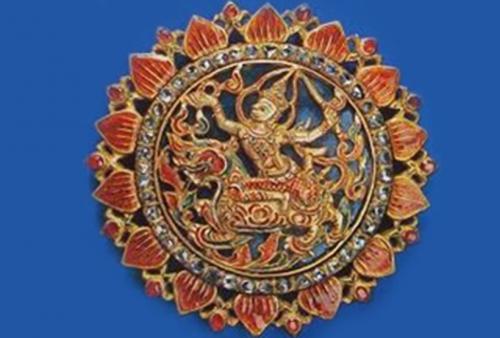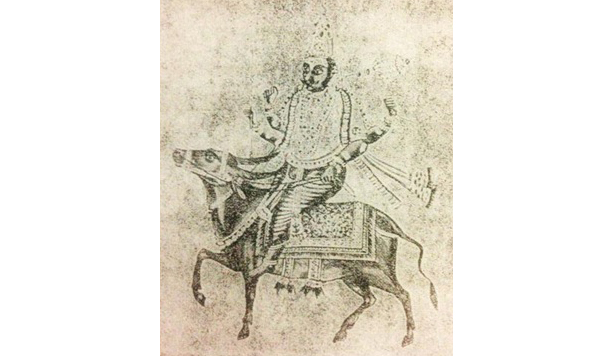Writer: Dao-napa Naowarangsee *
The belief regarding Yama
According to Brahmin-Hindu belief, Yama is the god of death. His abode is Yama-Pura or Yama-Loka, located in the south cardinal direction, outside the cosmos. His palace is named Kalichi. His throne is named Vicharabhu. According to Mahabharata, Yama has a large physique, and a menacing look. His body shines and is as transparent as crystal or as the rising sun. Yama wears a crown and has shiny eyes. However, another text says that Yama has a green-coloured body, wears blood-coloured clothes. Yama’s vehicle is a buffalo or a lion. In one hand he holds a large baton called Kala Danda or Yama Danda. His eyes serves as a weapon, called Nayana-Avudha. He also has a rope to catch and bind sinned living beings. The rope is called Yama-pasa.
There are several accounts on the origin of Yama. Some says Yama was a king of Phai Sali. One time during a ferocious war, Yama stated a wish to be the king of hell. After his death, he reincarnated in hell as he had wished, along with 18 of his generals and 80,000 soldiers who were given various duties, for example, as an assistant of justice, a warden, or an executioner. Other text says that Yama is the first human of the 7th world era. He is the son of Vivasvat (the sun god) and of Saranya whose name means the one who is conscious or the one who remembers. He has a twin sister named Yami or Yamuna who acts as chief of justice and oversees female culprits. Later Yami became the wife of Yama. (The pair is seen as the origin of mankind, similar to Adam and Eve in Christian belief.)
An Indian painting of Yama (c. 1820)
The main duty of Yama is acting as a Lokapala, or the guardian of the south cardinal direction. (Thus, Indian people normally do not build a house to face the South.) He is the judge of the dead by their good and bad merits. If they have done more good deeds, he would send them to heaven. If more bad deeds have been committed, he would send them to hell to pay for their sins. It is the responsibility of Yama to judge fairly. Hence he earned the name Dharma or Dharmaracha. Additionally, Yama is called by many other names, for example, Yamaraja, Majuracha, Mrityu-kala, Antaka, Kritanka, Samana, Dandi, Dandadhara, Bhimasena, Pasi, Pitripati, Pretaraja, Sraddha Deva, Vivaswat. In the Veda text, Yama is called "Sanga Mano Jananam” which means ‘that who gathers men’, or ‘who presides over the ancestors of all’. In Islam, Yama is called Azrail who weighs the souls of the dead according to their deeds. Islamic hell is called Jahannam which means the residence of Yama. In Hand-Book of Chinese Buddhism, Yama is called, according to Chinese tradition, ‘Yan Mo Luo’ which means the guardian of the dark, or Shuang Wang which means the king of double duties. The latter refers to Yama’s duties as a judge and at the same time the criminal. This is because it is believed that Yama and his attendants must serve the sentence for their sins from the past lives by allowing a demon to pour boiling copper into their mouths three times every 24 hours, until their sins are expiated. Then, he will be reborn as Samataracha. Every name of Yama associates with death.
Yama has 13 wives, all of them are the daughters of Daksha the progenitor, including:
1. Satha, with whom Yama has a son named Kama (love).
2. Lakshmi, with whom Yama has a son named Saap (pride).
3. Tharuti, with whom Yama has a son named Niyama (fondness).
4. Dusadee, with whom Yama has a son named Sandoz (barrier).
5. Pusadee, with whom Yama has a son named Lobha (desire).
6. Metha, with whom Yama has a son named Sarut (that is heard).
7. Kiriya, with whom Yama has a son named Danda (correction).
8. Buddhi, with whom Yama has a son named Bodhi (understanding).
9. Latcha, with whom Yama has a son named Vinai (good manner)
10. Vapu, with whom Yama has a son named Phya Bsai (diligent)
11. Shanti, with whom Yama has a son named Kasem (harmfree)
12. Sithi, with whom Yama has a son named Sukha (wellness).
13. Kierti, with whom Yama has a son named Yodsa (famed)
Besides, Yama are mentioned many times in Thai literature, especially in Savitri which is composed by King Mongkut or King Rama VI. The king based the story on a story originally in the Mahabharata which is consider an ‘Itihas’, the chronicles of India. The story is about Savitri, the female protagonist, who begged Yama for her dying husband—Phra Satyawan’s life. Yama allowed Phra Satyawan to live as Savitri had wished. This shows both Yama’s power and mercy over life and death of humankind.
The Origin of the Seal of Yama on the Lion’s Back
The seal of Yama on the lion’s back is one of the seals that were mentioned in a charter from Ayutthaya period. It was stated that the seal belonged to Phaya Yommarat Inthrathibodi Si Lokakorn Thanthathorn Kromphra Nakhonban Aphaiphiri Borakromphahu. The term ‘Thanthathorn’ that appears in the title of Phraya Yommarat means the one who holds a Danda. Phraya Yommarat is responsible for the Interior Division.
Ayutthaya national chronicle mentioned the bestowment of positional seals to four ministers of the government. Phraya Yommarat(Interior Division) used the seal of Yama on the lion’s back. Phraya Thammathikorn(Royal Household Division) used the seal of meditating Indra (probably the symbol of Nandi). Phraya Phra Khlang(Finance Division) used the seal of a deity holding a lotus, and a thunderbolt on a lotus pedestal. Phraya Pholathep(Agricultural Division) used the seal of a musician deity. It appears that the seal Yama on the Lion’s back had been bestowed to the officers who took the title Phraya Yommarat until Rattanakosin period. The book the Royal Emblems and the Positional Seals mentioned about the seal of Yama on the Lion’s back, which writes,
"According to the dictionary of Hindu deities published by the Westerners, Nandi the bull is the vehicle of Shiva. In another sense, the bull represents the minister of the household of Shiva. Therefore, we might be able to conclude that using the symbol of the minister of the god’s household instead of the Yama symbol which is used for the minister of the Interior Division would not be reasonable. It is appropriate that the seal of Yama belongs to the minister of the Interior Division, as the name of the title, Phraya Yommarat, also suggest that way. However, [the name] duplicates that of the minister of the Royal Household, because Dharma is also a name of Yama. When the title of the minister of the Interior Division was named as Yommarat must have been when that particular minister was overseeing the affair. Also, the officer in the position of Chao Phraya Dharma must have neglected his duties. It is likely that the seal of Yama was put into use after the seal of Nandi the bull.”
The above is an account on the meaning of the title Phraya Yommarat(minister of Interior Division), and Phraya Thammathikorn(minister of the Royal Household), stating that the two are similar. However, it is observed that the seal of the bull which represents the latter might have been in use earlier than the seal of Yama which represents the former.
It has been found that Brahmin-Hindu belief in Indian and Khmer tradition holds that Yama rides upon a buffalo, uses a Danda as a weapon, as seen on the wall sculpture depicting hell on the balcony of Angkor Wat. However, there was a change regarding iconography of Yama in Thai tradition. The positional seal of the title Phraya Yommarat from Ayutthaya period up until Rattanakosin period is an image of Yama holding a sword on the right hand, a rowel on the left hand, riding on the back of a lion. This change probably has been due to an adjustment in iconography to better suit the context of use. Nevertheless, the idea regarding the duties of Yama remains the same. Yama, as the god of death, represents the position of Phraya Yommarat who holds the power to judge over a life of a wrongdoer.
The Dara Seal of Yama on Lion’s Back
In the period of King Rama V, the king commissioned an improvement and new addition to the positional Dara seals along with the accessories of the official ranks to be awarded to civil servants as traditionally required. The king commissioned a seal to be made with a symbol of Yama on lion’s back to be given to Chao Phraya Yommarat, the minister of Home division, to wear on the chest. The seal is made of gold, in a round shape, decorated with a design of lotus petals. On the seal, within a diamond frame, is an image of Yama on the lion’s back.The king awarded this order of seal to several officers who had taken this position up until feudal titles were discontinued. The seal of Yama on lion’s back is currently being exhibited at the Hall of Royal Regalia, Royal Decorations and Coins.

The Dara Seal of Yama on Lion’s Back
Although due to changes in the administration of the country, the title of Chao Phraya Yommarat, the bestowment of the seal and Dara of Yama on Lion’s back was discontinued. Nevertheless, the symbol of Yama on the lion’s back is still being used as an official seal of the Department of Corrections which was established during the reign of King Mongkut or King Rama VI. One major duty of Department of Corrections is to oversee correctional facilities, or places of detention. This is a good reflection of the underlying idea of Yama—the god who judges and punishes wrongdoers, which is deep-rooted in Thai society.
*A curator at Bureau of Grand National Treasure, the Treasury Department


